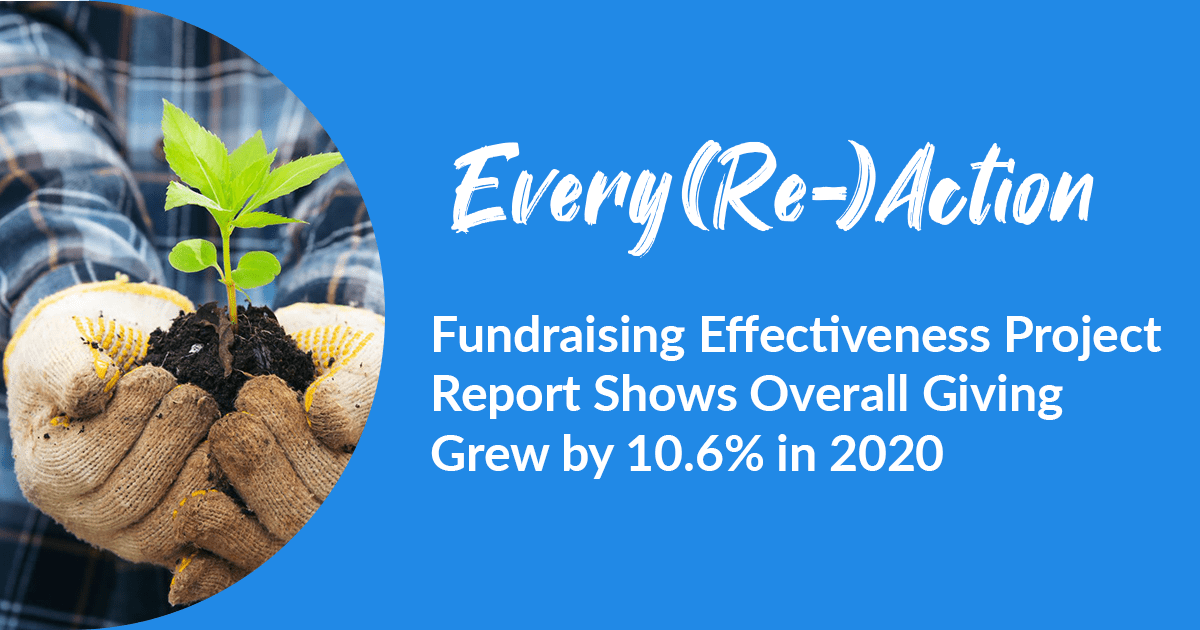Every(Re-)Action | Fundraising Effectiveness Project Report Shows Overall Giving Grew by 10.6 Percent in 2020

The Fundraising Effectiveness Project (FEP) in early March released a report documenting a 10.6 percent boost in giving for 2020, as compared to 2019. According to Ben Miller, vice chair of the FEP and Chief Analyst at DonorTrends, a division of EveryAction, the report reflects nonprofit organizations of a specific size range: those who in 2019 collected between $100K and $10 million in gifts.
WHAT WE KNOW
This overall climb in giving aligns with what we know about other segments of 2020 giving: foundations, corporations, and a small handful of individuals donated billions last year, largely prompted by the simultaneous crises of the COVID-19 pandemic, uprisings for racial justice, and natural disasters.
Miller noted that the report’s numbers do not reflect the entire nonprofit sector, as these gains did not materialize for many smaller organizations who were reliant on events, ticket sales, face to face projects, or whose missions were unrelated to the emergencies. Organizations that were able to pivot from their traditional fundraising and did not stop fundraising altogether were best positioned to weather the storm in 2020.
EFFECTS ON EVERYACTION CLIENTS
EveryAction clients, many of whom responded to these catastrophes, saw an increase in donors of nearly 20 percent in 2020.
This increase for EveryAction clients was led by a surge in new donors of 35 percent and reactivated donors of 25 percent. These mirror the FEP report, which saw 19 percent and 14 percent more new and reactivated donors, respectively.
“EveryAction clients saw an average increase of 55 percent in new donors from June to August. This highlights just some of the impact that social justice movements had in 2020,” said Miller.
GIFT SIZE AND DONOR RETENTION
Interestingly, the FEP’s report documented an increase in giving by small-dollar donors at a greater rate than larger donors. Some of the highlights include:
- Gifts of less than $250 grew by 15.3 percent over 2019.
- Gifts of $250 to $999 increased 8 percent.
- Gifts of $1,000 or more increased 10.4 percent.
Despite these documented leaps in giving for 2020, many nonprofits are now wondering about giving patterns moving forward. The FEP noted that while 2020 saw an overall increase in giving, that year’s donor retention rate dropped by 4.1 percent. Other statistics about the donor population in 2020 included:
The overall number of donors grew by 7.3 percent over 2019.
New donors were up by 18.5 percent.
Last year saw a nearly 14 percent increase in recaptured donors, or those whose last gift was two or more years ago.
OUR TAKE
Many nonprofits already know effective retention is the key to cost-effective fundraising, but it’s important to recognize that there’s really no one-size-fits-all retention plan nonprofits can apply equally to every single supporter. What’s more effective is to develop multi-channel, targeted stewarding and retention strategies for different donor audiences, based on all the information you already have about your supporters. Plans that are data-driven and tailored to donors can empower fundraisers to send the right messages, to the right people, via the right channels, at the right time – which leads to better retention.


